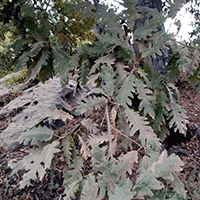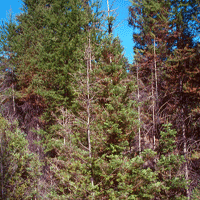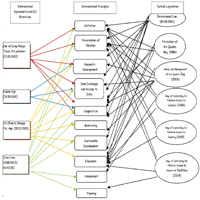Air pollution arising from different sources represents a serious environmental threat to all living organisms, including vegetation. Monitoring air contamination levels is necessary to detect pollution levels, regulate atmospheric pollution, and ultimately improve ambient air quality. The current study evaluated the effects of air pollutants with a focus on dust and some biochemical and physiological properties of Quercus cerris L., which is growing in Lebanon’s Ezer forest, threatened by the presence of a public road on its northern side. The studied parameters include leaf extract pH, stomatal conductance, relative water content, hydrogen peroxide, proline, carotenoids, and air pollution tolerance index. These parameters can provide reliable information about the tolerance status of plants towards pollutants. Three sites with different exposure to vehicular activities were used to conduct this study, including a control site (unpolluted) and two polluted sites (S1 and S2). The results showed a significant reduction in stomatal conductance and relative water content at polluted sites compared with the control site. Hydrogen peroxide, proline, and carotenoids showed the highest levels at the S2 site, which is indicative of the fact that Quercus cerris undergoes established physiological and biochemical changes in response to environmental stress. Based on the air pollution tolerance index (4.97-9.85) Quercus cerris is categorized as a sensitive species that can be used as a biological monitor of environmental pollution. Thus, the development and implementation of efficient environmental action plans based on biomonitoring should be considered for protecting the forests.
Keywords
, , , , ,
Citation
Najib R, Houri T, Khairallah Y, Khalil M (2022). Effect of dust accumulation on Quercus cerris L. leaves in the Ezer forest, Lebanon. iForest 15: 322-330. - doi: 10.3832/ifor3959-015
Academic Editor
Rossella Guerrieri
Paper history
Received: Sep 01, 2021
Accepted: Jun 13, 2022
First online: Aug 23, 2022
Publication Date: Aug 31, 2022
Publication Time: 2.37 months
© SISEF - The Italian Society of Silviculture and Forest Ecology 2022
Open Access
This article is distributed under the terms of the Creative Commons Attribution-Non Commercial 4.0 International (https://creativecommons.org/licenses/by-nc/4.0/), which permits unrestricted use, distribution, and reproduction in any medium, provided you give appropriate credit to the original author(s) and the source, provide a link to the Creative Commons license, and indicate if changes were made.

Breakdown by View Type
(Waiting for server response...)
Article Usage
Total Article Views: 31267
(from publication date up to now)
Breakdown by View Type
HTML Page Views: 26633
Abstract Page Views: 2487
PDF Downloads: 1728
Citation/Reference Downloads: 2
XML Downloads: 417
Web Metrics
Days since publication: 1226
Overall contacts: 31267
Avg. contacts per week: 178.52
Article Citations
Article citations are based on data periodically collected from the Clarivate Web of Science web site
(last update: Mar 2025)
Total number of cites (since 2022): 3
Average cites per year: 0.75
Publication Metrics
by Dimensions ©
Articles citing this article
List of the papers citing this article based on CrossRef Cited-by.
(1)
Adamiec E, Jarosz-Krzeminska E, Wieszala R (2016)Heavy metals from non-exhaust vehicle emissions in urban and motorway road dust. Environmental Monitoring and Assessment 188: 1-11.
CrossRef |
Gscholar
(2)
Agbaire PO, Akporhonor EE (2014)The effects of air pollution on plants around the vicinity of the Delta Steel Company, Ovwian-Aladja, Delta State, Nigeria. IOSR Journal of Environmental Science, Toxicology and Food Technology 8: 61-65.
Gscholar
(3)
Agbaire PO (2016)Impact of air pollution on proline and soluble sugar content of selected plant species. Chemistry and Materials Research 8: 72-76.
Online |
Gscholar
(4)
Anav A, Proietti C, Menut L, Carnicelli S, De Marco A, Paoletti E (2018)Sensitivity of stomatal conductance to soil moisture: implications for tropospheric ozone. Atmospheric Chemistry and Physics 18: 5747-5763.
CrossRef |
Gscholar
(5)
Arbona V, Manzi M, De Ollas C, Cadenas AG (2013)Metabolomics as a tool to investigate abiotic stress tolerance in plants. International Journal of Molecular Sciences 14: 4885-4911.
CrossRef |
Gscholar
(6)
Chauhan A (2010)Tree as bio-indicator of automobile pollution in Dehradun City: a case study. New York Science Journal 3: 88-95.
Gscholar
(7)
Fazer L (2003)Down with road dust. Environmental Health Perspectives 111: 892-895.
Gscholar
(8)
Garg A, Gupta NC (2020)The great smog month and spatial and monthly variation in air quality in ambient air in Delhi, India. Journal of Health and Pollution 10: 1-14.
CrossRef |
Gscholar
(9)
Garneir E, Berger A (1987)The influence of drought on stomatal conductance and water potential of peach trees growing in the field. Scientia Horticulturae 32: 249-263.
CrossRef |
Gscholar
(10)
Google Earth (2022)Ezer Forest Lebanon. Web site.
Online |
Gscholar
(11)
Gupta GP, Kumar B, Singh S, Kulshrestha UC (2016)Deposition and impact of urban atmospheric dust on two medicinal plants during different seasons in NCR Delhi. Aerosol and Air Quality Research 16: 2920-2932.
CrossRef |
Gscholar
(12)
Hossain MA, Bhattacharjee S, Armin SM, Qian P, Xin W, Li HY, Burritt DJ, Fujita M, Tran LSP (2015)Hydrogen peroxide priming modulates abiotic oxidative stress tolerance: insights from ROS detoxification and scavenging. Frontiers in Plant Science 6: 1-19.
CrossRef |
Gscholar
(13)
Hubai K, Kováts N, Teke G (2021)Effects of urban atmospheric particulate matter on higher plants using
Lycopersicon esculentum as model species. SN Applied Sciences 3: 1-9.
CrossRef |
Gscholar
(14)
Hu X, Tanaka A, Tanaka R (2013)Simple extraction methods that prevent the artifactual conversion of chlorophyll to chlorophyllide during pigment isolation from leaf samples. Plant Methods 9: 1-13.
CrossRef |
Gscholar
(15)
ICP Forests (2005)Revised 2005 international co-operative programme on assessment and monitoring of air pollution effects on forests. Web site.
Online |
Gscholar
(16)
Kameswaran S, Gunavathi Y, Krishna PG (2019)Dust pollution and its influence on vegetation-a critical analysis. Life Science Informatics Publications 5: 341-363.
Online |
Gscholar
(17)
Karatas I, Ozturk L, Demir Y, Unlukara A, Kurunc A, Duzdemir O (2014)Alterations in antioxidant enzyme activities and proline content in pea leaves under long-term drought stress. Toxicology and Industrial Health 30: 693-700.
CrossRef |
Gscholar
(18)
Khairallah Y, Houri T, Osta B, Romanos D, Haddad G (2018)Biomonitoring airborne pollution: a case study of “
Urginea maritima” species in Bentael natural reserve - Lebanon. Journal of Taibah University for Science 12: 723-729.
CrossRef |
Gscholar
(19)
Krishnaveni M, Chandrasekar R, Amsavalli L, Madhaiyan P, Durairaj S (2013)Air pollution tolerance index of plants at Perumalmalai Hills, Salem, Tamil Nadu, India. International Journal of Pharmaceutical Sciences Review and Research 20: 234-239.
Gscholar
(20)
Kumar L, Hemanth kumar NK, Jagannath S (2018)Assessment of air pollution impact on micromorphological and biochemical properties of
Pentas lanceolata Forssk. and
Cassia siamea Lam. Tropical Plant Research 5: 141-151.
CrossRef |
Gscholar
(21)
Lakshmi PS, Sravanti KL, Namuduri S (2008)Air pollution tolerance index of various plant species growing in industrial areas. The Ecoscan 2: 203-206.
Gscholar
(22)
Leghari SK, Zaidi MA (2013)Effect of air pollution in the leaf morphology of common plant species of Quetta city. Pakistan Journal of Botany 45: 447-454.
Online |
Gscholar
(23)
Lewis MB, Schupp EW, Monaco TA (2017)Road dust correlated with decreased reproduction of the endangered Utah shrub
Hesperidanthus suffrutescens. Western North American Naturalist 77: 430-439.
CrossRef |
Gscholar
(24)
Liang X, Zhang L, Natarajan SK, Becker DF (2013)Proline mechanisms of stress survival. Antioxidants and Redox Signaling 19: 998-1011.
CrossRef |
Gscholar
(25)
Liu L, Guan D, Peart D (2012)The morphological structure of leaves and the dust-retaining capability of afforested plants in urban Guangzhou, South China. Environmental Science and Pollution Research International 19: 3440-3449.
CrossRef |
Gscholar
(26)
Lohe RN, Tyagi B, Singh V, Tyagi PK, Khanna DR, Bhutiani R (2015)A comparative study for air pollution tolerance index of some terrestrial plant species. Global Journal of Environmental Science and Management 1: 315-324.
Online |
Gscholar
(27)
Matysik J, Alia Bhalu B, Mohanty P (2002)Molecular mechanisms of quenching of reactive oxygen species by proline under stress in plants. Current Science 82: 525-532.
Online |
Gscholar
(28)
Muthu M, Gopal J, Kim DH, Sivanesan I (2021)Reviewing the impact of vehicular pollution on road-side plants-future perspectives. Sustainability 13: 1-14.
CrossRef |
Gscholar
(29)
Prajapati SK (2012)Ecological effect of airborne particulate matter on plants. Environmental Skeptics and Critics 1: 12-22.
Online |
Gscholar
(30)
Rahul J, Jain MK (2014)An investigation in the impact of particulate matter on vegetation along the national highway: a review. Research Journal of Environmental Sciences 8: 356-372.
CrossRef |
Gscholar
(31)
Rai PK (2016)Impacts of particulate matter pollution on plants: implications for environmental biomonitoring. Ecotoxicology and Environmental Safety 129: 120-136.
CrossRef |
Gscholar
(32)
Reich P, Borchert R (1988)Changes with leaf age in stomatal function and water status of several tropical tree species. Biotropica 20: 60-69.
CrossRef |
Gscholar
(33)
Robinson MF, Heath J, Mansfield TA (1998)Disturbances in stomatal behavior caused by air pollutants. Journal of Experimental Botany 49: 461-469.
Online |
Gscholar
(34)
Schäfer KVR (2011)Canopy stomatal conductance following drought, disturbance, and death in an upland oak/pine forest of the New Jersey Pine Barrens, USA. Frontiers in Plant Science 2: 1-7.
CrossRef |
Gscholar
(35)
Sett R (2017)Responses in plants exposed to dust pollution. Horticulture International Journal 1: 53-56.
CrossRef |
Gscholar
(36)
Seyyednejad SM, Nikejad M, Yusefi M (2009)The effect of air pollution on some morphological and biochemical factors of
Callistemon citrinus in petrochemical zone in South of Iran. Asian Journal of Plant Sciences 8: 562-565.
CrossRef |
Gscholar
(37)
Sharma P, Jha AB, Dubey RS, Pessarakli M (2012)Reactive oxygen species, oxidative damage, and antioxidative defense mechanism in plants under stressful conditions. Journal of Botany 1: 1-26.
CrossRef |
Gscholar
(38)
Sharma B, Sharma S, Bhardwaj SK (2017a)Effect of pollution on relative water content in temperate species growing along National Highway 5 in Himachal Pradesh. International Journal of Advances in Science Engineering and Technology 5: 15-18.
Gscholar
(39)
Sharma B, Sharma S, Bhardwaj SK, Kaur L, Sharma A (2017b)Evaluation of Air Pollution Tolerance Index (APTI) as a tool to monitor pollution and green belt development: a review. Journal of Applied and Natural Science 9: 1637-1643.
CrossRef |
Gscholar
(40)
Shen Y, Li J, Gu R, Yue L, Wang H, Zhan X, Xing B (2018)Carotenoid and superoxide dismutase are the most effective antioxidants participating in ROS scavenging in phenanthrene accumulated wheat leaf. Chemosphere 197: 513-525.
CrossRef |
Gscholar
(41)
Smithers R, Harris R, Hitchcock G (2016)The ecological effects of air pollution from road transport: an updated review. Natural England Commissioned Report, Worcester, UK, pp. 1-38.
Gscholar
(42)
Sokolova GG, Khlebova LP, Kalgina MV (2020)Influence of technogenic pollution on the pigments concentration in the black poplar leaves (
Populus nigra L.) in Biiysk. Earth and Environmental Science 543: 1-4.
Online |
Gscholar
(43)
Szabados L, Savouré A (2010)Proline: a multifunctional amino acid. Trends in Plant Science 15: 89-97.
CrossRef |
Gscholar
(44)
Taib M, Rezzak Y, Bouyazza L, Lyoussi B (2020)Medicinal uses, phytochemistry, and pharmacological activities of
Quercus species. Evidence-Based Complementary and Alternative Medicine 2020: 1-20.
CrossRef |
Gscholar
(45)
Turfan N, Mese O (2019)Effects of air pollution on some chemical compounds of Cherry Laurel (
Prunus laurocerasus L.) in Kastamonu. Journal of Bartin Faculty of Forestry 21: 486-494.
Online |
Gscholar
(46)
US-EPA (2021a)Nitrogen dioxide (NO2) pollution. Web site.
Online |
Gscholar
(48)
US-EPA (2021c)Basic information about Carbon Monoxide (CO) outdoor air pollution. Web site.
Online |
Gscholar
(49)
Wang H, Shi H, Li Y (2011)Leaf dust capturing capacity of urban greening plant species in relation to leaf micromorphology. In: Proceedings of the “2011 International Symposium on Water Resource and Environmental Protection”. IEEE, 20-22 May 2011. Xi’an, China, pp. 2198-2201.
Online |
Gscholar


















